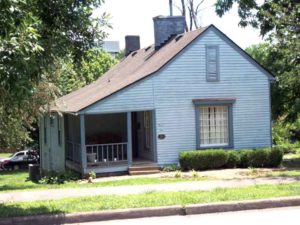Council upholds Historic Review Board action on South Fifth St. home

Homeowner Annette Filiatreau explains her point of view during an appeal hearing regarding the Historic Review Board’s denial of her applications for COAs on changes to her South Fifth Street home.
By JIM BROOKS
Nelson County Gazette / WBRT Radio
Monday, Oct. 2, 2017 (ADDED video, 6:45 p.m.) — The Bardstown City Council voted unanimously last week to uphold three Historic Review Board (HRB) recommendations that were challenged in regard to work on a historic home at 215 South Fifth St.
The owner of the home had most of the original wooden siding of the 1870 home removed without the board’s approval. After two stop-work orders were issued, the owner, Annette Filiatreau, applied to the HRB to replace the home’s siding with a concrete-based siding product.
VIDEO: Bardstown City Council HRB appeal, Sept. 26, 2017
Running time: 55 minutes.
Citing its preservation guidelines, the HRB denied her request to use the materials on her home. The guidelines require the exterior materials of a historic home to be replaced with like materials, in this case, the guidelines require that wood siding is used to replace the home’s original wood siding.

The Bardstown City Council upheld the Historic Review Board’s denial of three applications for Certificates of Appropriateness for changes to this home on North Fifth Street.
At the appeal last Tuesday night, Filiatreau did not offer evidence or testimony to support her desire to use the concrete-based wood-look siding. She told the council if she could not use the materials she wanted, she would like her home taken off the list of historic homes in the city’s Historic District.
Filiatreau said the HRB was not applying its own rules fairly.
“The material I’m asking for is clearly on other homes,” she said. “I’m not questioning the system, I’m questioning the integrity of the people on this board.”
She explained that she didn’t understand why she was being refused the use of the same material found on other homes in the Historic District. She gave examples of other homes that had the same siding.
“I just want it to be fair to everyone,” she said. “If I’m going to held to those standards of full-on historic, then everyone else needs to pull their stuff off and do the same — or allow me to do what has been allowed already.”
Filiatreau argued that investing in the masonry siding was a better material that lasts longer than wood siding, and was a better investment for her money.
“I want to get along with everybody, but I’m not going to back down from being treated fair.”
Mayor Dick Heaton explained that the masonry siding was allowed in the Historic District, but only on new construction.
Filiatreau said other types of siding are in use in the district, including vinyl and aluminum siding.
Two additional applications by Filiatreau for HRB Certificates of Appropriateness that were denied concerned window shutters and replacing the home’s windows.
Filiatreau asked to replace all the windows in the home, which she explained would be more energy efficient and make more sense than repairing the original wooden windows.
The cost to repair the original windows would be as expensive as replacing them, she explained. However, the district guidelines require repair of the windows as the preferable option.
Preservation Director RaShae Jennings told the council that a window contractor evaluated Filiatreau’s windows and in his report, stated they could be repaired. The windows are believed to be original to the home, and are an important element to the home’s historic nature, Jennings said.
Jennings said that repairing the existing windows and adding storm windows would offer nearly the same efficiency as new replacement windows.
As far as the home’s siding, Jennings reiterated that the district’s guidelines require historic materials to be replace with like materials, meaning that only wood siding can be used to replace original wood siding.
The historic preservation guidelines focus on what is best for a home based on the materials available during the era during which it was built, she explained.
Filiatreau suggested the HRB create a specific set of guidelines for each individual home in the historic district so that homeowners know what’s appropriate and is not for each individual home.
“I had no idea what a mess this would be just to try to repair a home,” she said. “When I purchased the home, there was nothing attached to the deed, there was nothing to say I would have to go through what I’ve gone through to deal with this.”
Councilman Joe Buckman said he understood the issue, but voiced support for the Historic Review Board and the historic district.
“It’s very important that we protect [the historic district], and the board has done a good job with that,” he said, adding that he felt it would be appropriate to uphold the HRB’s recommendations.
Councilman John Kelley told Filiatreau that as preservation coordinator, Jennings was one of the best resources a historic homeowner has.
“She can explain the historical review process, she can give you recommendations, and be a great asset.”
The council’s unanimous vote upheld the Historic Review Board’s recommendation to deny the use of imitation wood siding as well as replacing all of the home’s windows.
The property owner’s next level of appeal is Nelson Circuit Court.
-30-






